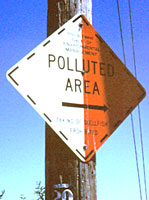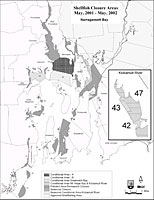 | ||||||||
 |
Policy and ManagementShellfish Bed Closures (Courtesy of Rhode Island Department of Environmental Management) Scientists, management officials and members of the shellfishing industry are all deeply concerned with the biology, ecology, production, economics and management of shellfish resources - clams, oysters, mussels, scallops, snails, shrimp, lobsters, crabs, among many other species of commercial importance. Shellfishing is an important industry in most major estuaries. Population declines in recent years indicate environmental stress. Most shellfish have specific habitat needs. For example mussels and oysters require firm substrates like rocks to attach themselves. Shellfish also need water temperature on the cool side. High temperatures greater than 24 - 27 C may be lethal to them. Although quahogs can be found along the North American Atlantic coast from Canada's Gulf of St. Lawrence to Florida, they are particularly abundant between Cape Cod and New Jersey. Rhode Island, situated right in the middle of "quahog country," has supplied a quarter of the nation's total annual commercial quahog catch. Today, the quahog is by far the most commercially important resource harvested from Narragansett Bay. Pollution in Narragansett Bay affects the quahog industry because quahogs are filter feeders, meaning that they take water in through a siphon and pass it over their gills which are specially adapted to filter out food (microscopic algae and other small organic particles). The filtered water is then expelled via another siphon. Unfortunately, not only do the gills filter out food, they also filter and concentrate many pollutants, including disease-causing bacteria and viruses, and toxic compounds. Therefore, even though pollutants may be at low levels in the water, they can accumulate to dangerous levels in filter feeders. About one quarter of Narragansett Bay's total area (including the Providence River and Mount Hope Bay) is permanently closed to shellfishing because of the danger of sewage contamination and heavy metal and organic pollutants in the sediment. In addition, a portion of the upper Bay is closed after rainfalls because antiquated "combined sewage" allows inadequately treated sewage to enter the Bay during rainstorms.
Problems that affect shellfish include algal blooms that deplete the water of oxygen. The algal blooms are often toxic to shellfish larvae, particularly oyster larvae. Adult shellfish that have ingested dinoflagellates are toxic to humans. Shellfish can also accumulate heavy metals from the phytoplankton and zooplankton they eat. Because of the ease of metal transfer up the food chain, shellfish often serve as bioindicators in areas contaminated with heavy metals.
|
|||||||
